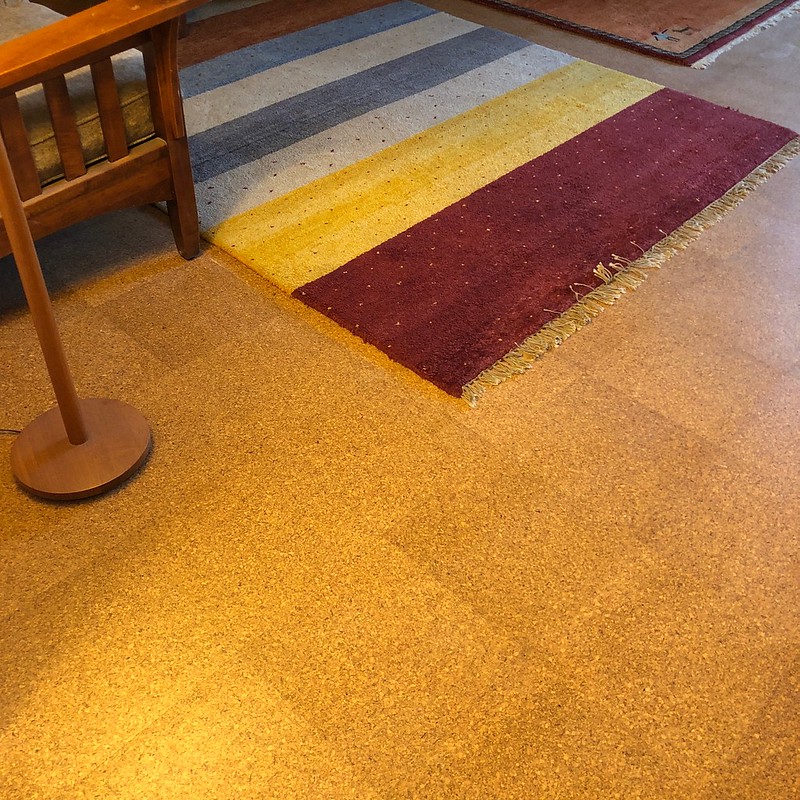Cork flooring
Contents |
[edit] Introduction
The term ‘flooring’ refers to the lower enclosing surface of spaces within buildings. This may be part of the floor structure, such as the upper surface of a concrete slab or floor boards, but typically it is a permanent covering laid over the floor. There are many types of flooring materials available.
For more information see Types of flooring.
[edit] Resilient flooring
Resilient flooring is loosely defined as flooring manufactured from elastic materials. Products made out of these materials share certain characteristics - they are durable and firm, but they also offer a degree of 'bounce' or resilience. Cork is one type of resilient flooring. It is also one of the natural components used in linoleum flooring.
For more information see Linoleum.
[edit] History of cork
Cork is a product most commonly harvested from the outer bark of the cork oak. Its ability to survive and regenerate is one of the characteristics that makes it appealing as a sustainable material.
The Ancient Greeks and Romans used cork in construction, insulation and other applications that required building materials that were strong, plentiful, water resistant and buoyant. In the 1700s, these properties brought cork to the forefront as the ideal material for wine bottle stoppers.
As flooring, cork was used in Spanish and Portuguese cathedrals built in the 1800s. As some of the primary producers of the world’s cork, these countries had an abundance of the material, which was also used in shipbuilding and in the production of other nautical materials.
[edit] Cork flooring applications
It was re-introduced as a flooring product around 1900, and became one of the most popular resilient flooring options. In North America, it was used in the Library of Congress in Washington, DC (built in the 1890) and the old Toronto Stock Exchange (built in the early 1900s).
Cork was also a frequent choice for Frank Lloyd Wright, including in one of his best-known projects - Fallingwater. Because of their warmth and colour, cork tiles were requested by the wealthy Kaufmann family for both the floors and the walls of the six bathrooms in the house.
Cork flooring also became popular as an everyday flooring in homes built during the 1920s to 1940s. Its characteristics also made it a common choice for restaurants, gymnasiums, libraries or other facilities where resiliency and quiet were important. In addition, cork’s water and mildew resistance made it suitable for spaces such as basements and bathrooms.
In these earlier instances, cork tiles were large and solid. They could be sanded and finished just like hardwood floors and were extremely durable. Over time, manufacturers reduced the thickness of the cork tiles and added decorative veneers, which were not always structurally viable. Sales of cork flooring dropped as a result of this and other issues.
[edit] Cork flooring characteristics
As a sustainable, water resistant, fire resistant and even insect resistant material, cork flooring has regained its popularity through modern reengineering and improved installation methods. Modern cork flooring can be clicked and locked together in the same way as laminates. They can also be glued down.
They are available in tile and floating plank form and can also be used as flooring underlay or joint filler.
[edit] Maintenance
Cork floors are 'warm' and flexible, although they do require regular maintenance. This includes:
- Sweeping and vacuuming to prevent the accumulation of debris (which can scratch surfaces).
- Keeping the floor relatively dry (despite its water resistant nature, cork can be damaged by water that is left in puddles). Washing with a damp towel is a preferred method of cleaning.
Other important care considerations:
- Floor mats should be used for water prone areas such as entrances or in front of sinks.
- Window coverings should be used to protect cork from extended exposure to sunlight.
- Furniture pads can be used to protect cork from indentations caused by heavy furniture.
Despite preventive maintenance efforts, cork floors can be damaged by sharp objects.
There are long-term measures that can be taken to make cork surfaces more durable. Sealing (often with an invisible ultraviolet protective type of polyurethane) can help protect cork floors from UV degradation, water and other damaging stains. Some floors come prefinished with protective sealant, but may require reapplication on a regular basis (once every year or two).
At the end of its life, cork can be recycled.
[edit] Related articles on Designing Buildings
Featured articles and news
Homes England creates largest housing-led site in the North
Successful, 34 hectare land acquisition with the residential allocation now completed.
Scottish apprenticeship training proposals
General support although better accountability and transparency is sought.
The history of building regulations
A story of belated action in response to crisis.
Moisture, fire safety and emerging trends in living walls
How wet is your wall?
Current policy explained and newly published consultation by the UK and Welsh Governments.
British architecture 1919–39. Book review.
Conservation of listed prefabs in Moseley.
Energy industry calls for urgent reform.
Heritage staff wellbeing at work survey.
A five minute introduction.
50th Golden anniversary ECA Edmundson apprentice award
Showcasing the very best electrotechnical and engineering services for half a century.
Welsh government consults on HRBs and reg changes
Seeking feedback on a new regulatory regime and a broad range of issues.
CIOB Client Guide (2nd edition) March 2025
Free download covering statutory dutyholder roles under the Building Safety Act and much more.
Minister quizzed, as responsibility transfers to MHCLG and BSR publishes new building control guidance.
UK environmental regulations reform 2025
Amid wider new approaches to ensure regulators and regulation support growth.
BSRIA Statutory Compliance Inspection Checklist
BG80/2025 now significantly updated to include requirements related to important changes in legislation.























